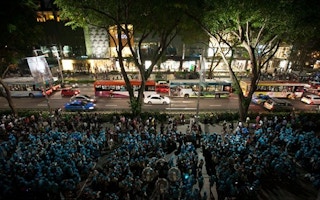Sustainability has often been pitched as a way of reducing costs so as to gain acceptance within the business community. However, the concept now needs to move away from simplistic cost savings and towards value creation, said speakers at the second day of the International Green Building Conference 2012.
The reason? To engage the wider public.
Co-founder of Earth Hour, Mr Andy Ridley, told a plenary session: “The thing about the environmental movement is that we’re often talking to ourselves.”
Sustainability, he pointed out, is currently cast as an aspiration – something to look up to – but it should be much more than that. How does one convince individuals - from CEOs to schoolchildren - to adopt it as a lifestyle?
The trick, he said, is to use it to create human relationships. Recounting how he and his team turned Earth Hour from a simple idea into a globally accepted event, he said that to engage the bulk of the population, there has to be a brand people can recognise and identify with first of all.
So the Earth Hour team created a brand, complete with logo and tagline, and used social media as an engine to spread awareness of the event.
Now, said Mr Ridley, the event is so widely known that its aim is no longer to spread awareness but to bring people together. Earlier this year, he and his team launched an “I Will If You Will” campaign on social media for individuals to match each other’s sustainability efforts.
The campaign involves people challenging others to sustainability actions in exchange for a goodwill pledge. For example, someone might pledge to dye their beard green if 1000 people promise to recycle their household rubbish for a week, or pledge to join a pro-environment demonstration if a certain amount of funds can be raised for a charity. All are welcomed, said Mr Ridley.
“We encourage people to hijack Earth Hour,” he explained, pointing out that doing so allows the event, with all its environmentally friendly connotations, to become integrated into the public mindset.
Bringing green buildings into the community eye
What can be done with an event, can and should be done with buildings, said real estate developers and architects speaking during the same session.
From the developers’ perspective, there is a need to recognise buildings as part of a community, said Mr David Nieh, director of sustainability for Asia at Lend Lease.
Sustainability is not just about infrastructure, although there is plenty of technical expertise involved in areas such as the integration of green utilities with green buildings. It is about the people who are going to live in the building when it is completed.
“We need to understand people’s needs and how to answer those needs,” added Mr Massimo Roj, the managing partner of Italian integrated design company Progetto CMR.
This, he elaborated, includes creating cultural awareness of the sustainability challenge through knowledge exchange – debates, conferences, books, the new media – and promoting the transfer of sustainability-related skills in the construction sector.
Furthermore, he noted, everyone, including current and future users of the space being developed, is a “fundamental actor on the stage”.
Building designers and developers can only do so much; each individual needs to accept responsibility for promoting the new characteristics of a sustainable city and passing these characteristics on to the next generation.
This idea of green buildings being an integral part of communities and cultures is one that sorely needs to be propagated, said Dr Nirmal Kishnani, programme director at the National University of Singapore’s School of Design and Environment.
“Green buildings are discussed as technical objects, but seldom as objects of cultural change,” pointed out Dr Kishnani, who is also editor-in-chief of green architecture publication FuturArc Journal.
Making a building or even an entire estate sustainable need not, and should not, be a one-way effort by developers or managers, he said.
Residents’ input is crucial to sustainability discussions – what changes should be made, what features to include, how it can be done. The idea is not just to create infrastructure that caters to their needs, but to engage the community and turn the sustainability concept into common ground for people to come together .
Ultimately, said Mr Nieh, sustainability is not just about making a building better for the environment, although that is a major factor. It is also about creating value by improving the community and making people’s lives better.
And how can green buildings do that? By providing them with access, he said. Not only to green utilities, but to education, parks, goods and services, transportation, healthcare, and “all the things that delight us in life.”
Eco-Business.com’s coverage of the International Green Building Conference 2012 is brought to you by City Developments Limited (CDL).















